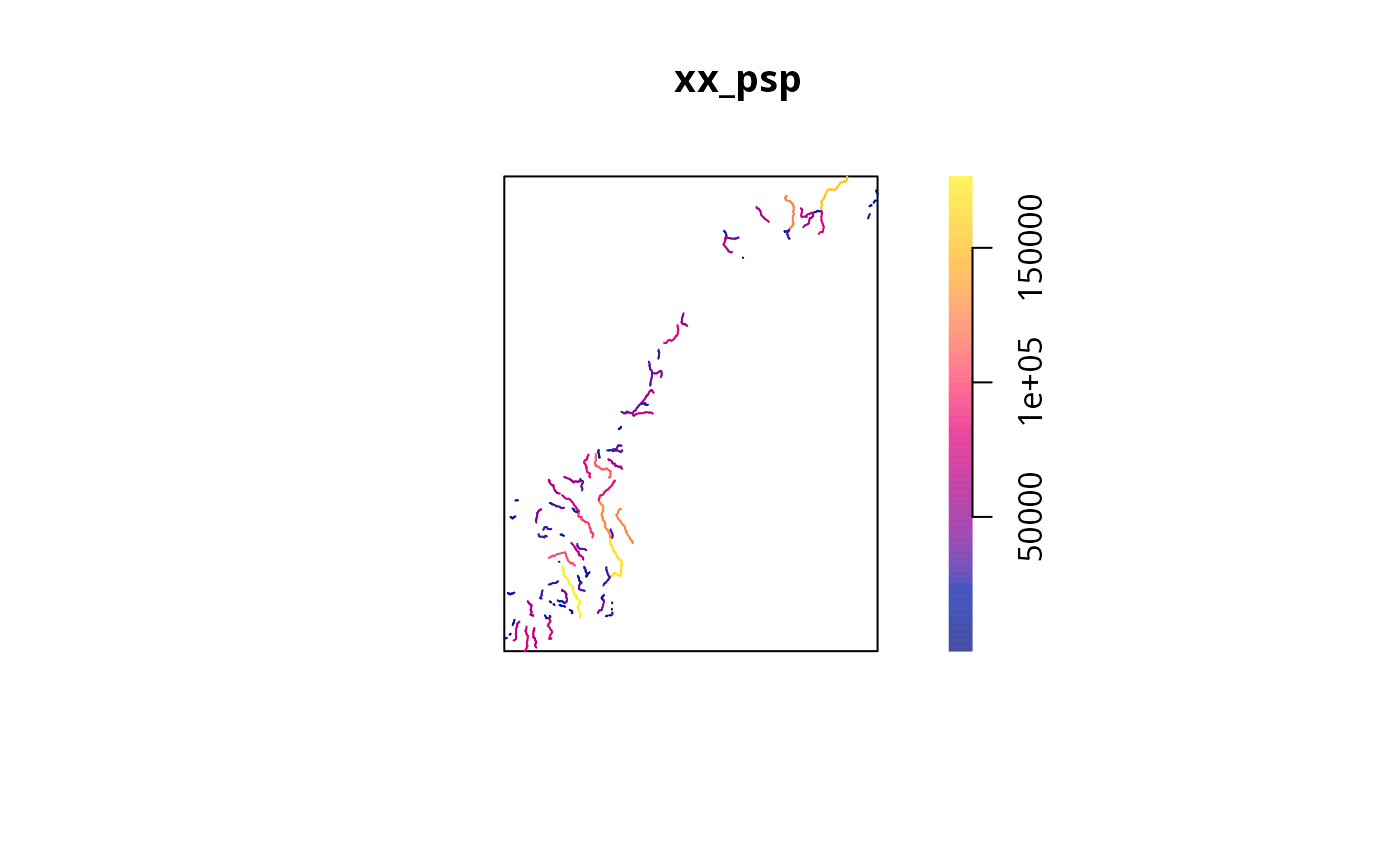Coercion between sp objects and spatstat psp objects
as.psp.RdFunctions to convert between spatstats planar segment pattern (psp)
format and various sp line formats. S4-style as() coercion can be
used as well.
as.psp.Line(from, ..., window=NULL, marks=NULL, fatal)
as.psp.Lines(from, ..., window=NULL, marks=NULL, fatal)
as.psp.SpatialLines(from, ..., window=NULL, marks=NULL, characterMarks
= FALSE, fatal)
as.psp.SpatialLinesDataFrame(from, ..., window=NULL, marks=NULL, fatal)
as.SpatialLines.psp(from)Methods
- coerce
signature(from = "Line", to = "psp")- coerce
signature(from = "Lines", to = "psp")- coerce
signature(from = "SpatialLines", to = "psp")- coerce
signature(from = "SpatialLinesDataFrame", to = "psp")- coerce
signature(from = "psp", to = "SpatialLines")
Arguments
- from
object to coerce from
- ...
ignored
- window
window of class
owinas defined in the spatstat package- marks
marks as defined in the spatstat package
- characterMarks
default FALSE, if TRUE, do not convert NULL marks to factor from character
- fatal
formal coercion argument; ignored
Warning
In spatstat all spatial objects are assumed to be planar. This means
that spatstat is not designed to work directly with geographic
(longitude and latitude) coordinates. If a sp object is declared to
have geographic (unprojected) coordinates maptools refuses to convert
directly to spatstat format. Rather, these should be projected first
using e.g. spTransform. If you know what you are doing, and
really want to force coercion, you can overwrite the proj4string of the
sp object with NA, proj4string(x) <- CRS(NA), which
will fool the system to think that the data is in local planar coordinates.
This is probably not a good idea!
Examples
run <- FALSE
if (require("spatstat.geom", quietly=TRUE)) run <- TRUE
if (run) {
data(meuse.riv)
mr <- Line(meuse.riv)
mr_psp <- as(mr, "psp")
mr_psp
}
#> planar line segment pattern: 175 line segments
#> window: rectangle = [178304, 182331.5] x [325698.5, 337684.8] units
if (run) {
plot(mr_psp)
}
 if (run) {
xx_back <- as(mr_psp, "SpatialLines")
plot(xx_back)
}
if (run) {
xx_back <- as(mr_psp, "SpatialLines")
plot(xx_back)
}
 if (run) {
xx <- readShapeLines(system.file("shapes/fylk-val.shp", package="maptools")[1],
proj4string=CRS("+proj=utm +zone=33 +ellps=WGS84"))
xx_psp <- as(xx["LENGTH"], "psp")
xx_psp
}
#> Warning: shapelib support is provided by GDAL through the sf and terra packages among others
#> marked planar line segment pattern: 1094 line segments
#> marks are numeric, of type ‘double’
#> window: rectangle = [-4867.8, 1084721.9] x [6456207, 7841997] units
if (run) {
plot(xx_psp)
}
if (run) {
xx <- readShapeLines(system.file("shapes/fylk-val.shp", package="maptools")[1],
proj4string=CRS("+proj=utm +zone=33 +ellps=WGS84"))
xx_psp <- as(xx["LENGTH"], "psp")
xx_psp
}
#> Warning: shapelib support is provided by GDAL through the sf and terra packages among others
#> marked planar line segment pattern: 1094 line segments
#> marks are numeric, of type ‘double’
#> window: rectangle = [-4867.8, 1084721.9] x [6456207, 7841997] units
if (run) {
plot(xx_psp)
}
 if (run) {
xx_back <- as(xx_psp, "SpatialLines")
plot(xx_back)
}
if (run) {
xx_back <- as(xx_psp, "SpatialLines")
plot(xx_back)
}
 if (run) {
xx <- readShapeLines(system.file("shapes/fylk-val-ll.shp", package="maptools")[1],
proj4string=CRS("+proj=longlat +ellps=WGS84"))
try(xx_psp <- as(xx["LENGTH"], "psp"))
}
#> Warning: shapelib support is provided by GDAL through the sf and terra packages among others
#> Error in as.psp.SpatialLinesDataFrame(from) :
#> Only projected coordinates may be converted to spatstat class objects
if (run) {
xx <- readShapeLines(system.file("shapes/fylk-val-ll.shp", package="maptools")[1],
proj4string=CRS("+proj=longlat +ellps=WGS84"))
try(xx_psp <- as(xx["LENGTH"], "psp"))
}
#> Warning: shapelib support is provided by GDAL through the sf and terra packages among others
#> Error in as.psp.SpatialLinesDataFrame(from) :
#> Only projected coordinates may be converted to spatstat class objects